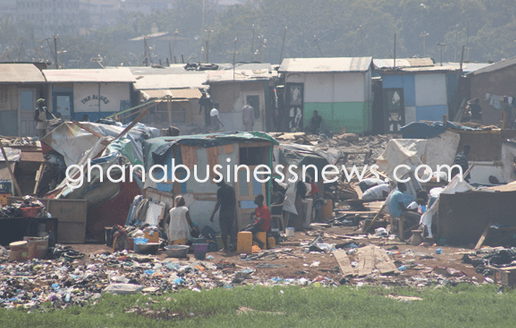Two out of five persons live in slums in Ghana – NDPC Report
 About two out of five of the population live in slums, a report by the National Development Planning Commission (NDPC) on the Sustainable Development Goals (SDGs) has revealed.
About two out of five of the population live in slums, a report by the National Development Planning Commission (NDPC) on the Sustainable Development Goals (SDGs) has revealed.
The report says as of 2017, the proportion of the population living in slums stood at 39.3 per cent, with the figure slightly dropping to 39.2 per cent in 2018, and further declining marginally to 38.9 per cent in 2019.
Professor George Gyan-Baffour, Chairman, NDPC, launched the ‘2020 Sustainable SDGs and the African Union (AU) Agenda 2063’ reports in Accra on Tuesday.
The objective of the two reports was to assess progress made towards achieving the AU Agenda 2063 and SDGs targets and find out whether Ghana is on track towards achieving the targets of the two agendas.
Whereas the SDG Goal 11.1 targets access to adequate, safe and affordable housing and basic services and upgrade of slums by 2030, the AU Agenda 2063 targets a reduction of slums by at least 10 per cent.
According to the United Nations, an estimated three billion people will require adequate and affordable housing by 2030.
On Goal one of the SDGs (end poverty in all its forms everywhere), the NDPC Report showed that the proportion of Ghanaians who were classified as poor based on the national definition, reduced from 24.2 per cent in 2013 to 23.4 per cent in 2017.
The report, however, indicated that in absolute terms, the total number of the poor increased by about 400,000.
“As of 2017, there were poorer male-headed (25.8 per cent) than female-headed households (17.6 per cent). Irrespective of the ecological zone, the incidence of poverty is higher among the rural population.
“The rural savannah zone has experienced a rise in the proportion of poor households from 55 per cent in 2013 to 64 per cent in 2017,” it said.
On inclusive and equitable education, the Report said the country, on the average, had achieved and maintained the gender parity for KG (1.03 per cent), Primary (1.02 per cent), and JHS Levels (1.02 per cent) between 2016/2017 and 2019/2020 academic years.
On health, it indicated that with the current maternal mortality ratio of 310 per 100,000 live births, the country was off-track of achieving the SDG target of 70 deaths per 100,000 live births by 2030.
The Report also showed that the country missed the universal access to sanitation services target set by the SDGs, with the proportion of the population using safely managed sanitation services standing at 13 per cent in 2020.
It said the country was likely to make significant progress towards universal access to at least basic drinking water services by 2030, with 86 per cent of the population having access to basic drinking water services in 2020.
Prof. Gyan-Baffour said despite the successes recorded in achieving the SDGs and the AU Agenda, many areas needed urgent attention to ensure that more targets were met going forward.
“Close to one-fourth of children do not have the minimum proficiency in mathematics and reading; a majority of the population lack access to basic sanitation services; the tourism sector largely remains under-developed; access to decent jobs remains a challenge; income inequality is on the rise, and the menace of illegal mining is destroying large tracts of forest and water bodies,” he noted.
Dr Kodjo Mensah-Abrampa, Director-General, NDPC, said the COVID-19 pandemic had derailed progress towards achieving the targets, and called for more support from the private sector, traditional authorities and civil society organisations to mobilise resources to achieve the targets.
Ghana has been implementing the AU Agenda 2063 and the 2030 Agenda for Sustainable Development since their adoption in January and September 2015, respectively.
Source: GNA
